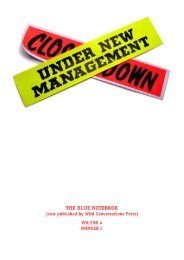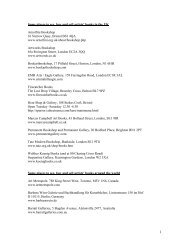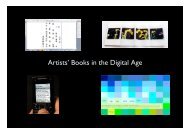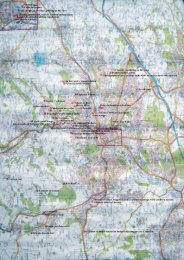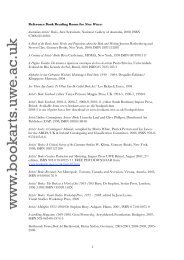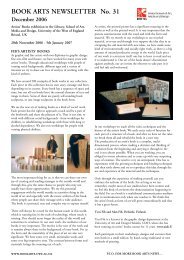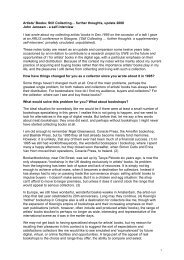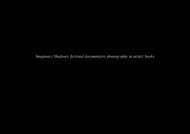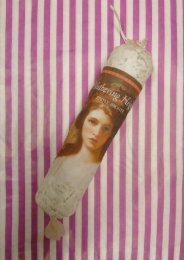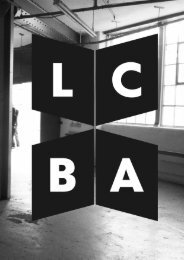Artist's Book Yearbook 2003-2005 - Book Arts - University of the ...
Artist's Book Yearbook 2003-2005 - Book Arts - University of the ...
Artist's Book Yearbook 2003-2005 - Book Arts - University of the ...
You also want an ePaper? Increase the reach of your titles
YUMPU automatically turns print PDFs into web optimized ePapers that Google loves.
doodle in a spiral-bound notebook, through its<br />
various permutations and its eventual<br />
emergence as a work <strong>of</strong> art. We see how he<br />
‘cooks <strong>the</strong> books’ (<strong>the</strong> title <strong>of</strong> <strong>the</strong> Center’s<br />
exhibition), carefully working out <strong>the</strong> details <strong>of</strong><br />
every publication before production begins.<br />
As Ron says, ‘My mind is like a cauldron.<br />
There’s a great stew <strong>of</strong> things going round and<br />
round. In <strong>the</strong> end I serve up a dish.’<br />
Researchers can read correspondence between<br />
Ron and his many collaborators. A revealing<br />
example is Ron’s collaborations with <strong>the</strong> poet<br />
Roy Fisher, during which <strong>the</strong> two <strong>of</strong> <strong>the</strong>m rarely<br />
met in person; <strong>the</strong>ir frequent written exchanges<br />
demonstrate <strong>the</strong> richness and complexity <strong>of</strong><br />
<strong>the</strong>ir partnership.<br />
Fisher has said recently that his collaboration<br />
with Ron on The Half-Year Letters (one <strong>of</strong> a<br />
number <strong>of</strong> projects exploring folded and cut<br />
letters that Circle Press has published over <strong>the</strong><br />
years) was <strong>of</strong> a ‘musical nature. Ron already<br />
had a very dogmatic master text, so I thought I<br />
would have a voice and a disposition muttering<br />
along with his letters.’<br />
This is interesting <strong>of</strong> course, but it is in <strong>the</strong><br />
original correspondence that we find <strong>the</strong><br />
details <strong>of</strong> <strong>the</strong> project. Roy Fisher wrote to Ron<br />
in February <strong>of</strong> 1983: “This enormous text has<br />
taken a long while and has grown like a sack <strong>of</strong><br />
potatoes from small beginnings. What I’ve tried<br />
to do is establish a fairly vague text … which<br />
doesn’t dramatise your letter forms in any<br />
obvious way. My reactions to <strong>the</strong>m are<br />
submerged in my text….’<br />
For The Half-Year Letters Fisher took a random<br />
starting date from his own diaries and extracted<br />
events and observations from a twenty-six week<br />
span. From this list, he constructed <strong>the</strong> poetic<br />
text: ‘The actual images have <strong>the</strong>ir starts in<br />
notes, diary dates, lecture titles & memoranda<br />
and anecdotes picked out <strong>of</strong> a sequence <strong>of</strong> 26<br />
weeks a while back (i.e., half a year - which<br />
might give us a title or part <strong>of</strong> one) - but I’ve<br />
tried to leave <strong>the</strong>m loose enough for you to<br />
inhabit. Plain point, though, is that this is a<br />
maximum text, from which you can use<br />
whatever chunks & slivers are <strong>of</strong> use, and<br />
discard or downgrade (design-wise) <strong>the</strong> rest.’<br />
4<br />
The archive, toge<strong>the</strong>r with copies <strong>of</strong> all <strong>the</strong><br />
published books, make <strong>the</strong> holdings at <strong>the</strong> Yale<br />
Center for British Art <strong>the</strong> most comprehensive<br />
collection <strong>of</strong> Circle Press in <strong>the</strong> world. Ron says<br />
that <strong>the</strong>ir ‘most ardent support has always come<br />
from <strong>the</strong> U.S., without which we never would<br />
have been able to survive as an independent<br />
self-supporting “workshop”… all this, as it were,<br />
under a British ro<strong>of</strong> in a very fine building on<br />
American soil, couldn’t be more appropriate or<br />
gratifying.’<br />
In a poignant tribute, Ron and Willow are<br />
giving <strong>the</strong> archive in memory <strong>of</strong> <strong>the</strong>ir son<br />
Daniel, who died <strong>of</strong> cancer at <strong>the</strong> age <strong>of</strong> fifteen<br />
in 1972. It will be known as <strong>the</strong> Daniel King<br />
Circle Press Archive, to be kept in perpetuity at<br />
<strong>the</strong> Yale Center for British Art and open to all<br />
for research. Ron describes Daniel as “an<br />
extremely bright, intelligent young man with a<br />
highly developed social conscience, a good<br />
draughtsman, and a keen stamp collector.<br />
I didn’t realise <strong>the</strong> full extent <strong>of</strong> his collection<br />
until after his death; I actually based some<br />
prints on his penny blacks, penny reds, and<br />
two-penny blues and dedicated <strong>the</strong>m and <strong>the</strong><br />
portfolio Neighbours, We’ll Not Part Tonight to his<br />
memory, but as we have no headstone or<br />
plaque for him, an archive in his name, made<br />
available mainly to young people, seems a<br />
fitting alternative and one <strong>of</strong> which he would<br />
approve.’<br />
The exhibition Cooking <strong>the</strong> <strong>Book</strong>s: Ron King and<br />
Circle Press opened in June 2002 at <strong>the</strong> Yale<br />
Center for British Art. It celebrated both <strong>the</strong><br />
gift <strong>of</strong> <strong>the</strong> Daniel King Circle Press Archive and<br />
<strong>the</strong> thirty-fifth year <strong>of</strong> <strong>the</strong> Press’s existence.<br />
While <strong>the</strong>re have been o<strong>the</strong>r exhibitions <strong>of</strong><br />
Circle Press books, this was <strong>the</strong> first time that<br />
preliminary drawings, original collages,<br />
linoleum blocks, experimental letters, and<br />
correspondence were on display along with <strong>the</strong><br />
finished projects - <strong>the</strong> ‘recipes that led to a<br />
dish,’ as Ron put it. The exhibition’s<br />
provocative title attracted some media attention<br />
(<strong>the</strong> exhibition happened to open just as a<br />
nation-wide accounting scandal was unfolding),<br />
but as Grace Glueck from <strong>the</strong> New York Times<br />
wrote, <strong>the</strong> exhibition ‘has nothing to do with<br />
corporate chicanery and everything to do with<br />
<strong>the</strong> wonderfully imaginative publications <strong>of</strong><br />
Mr. King, a maverick British publisher.’




